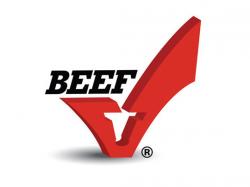Optimism In Air At Beef Checkoff Meetings
August 8, 2014 | 4 min to read

Strong cattle and beef prices, tremendous results from a return-on-investment study, an industry forecast ripe with opportunity, and an engaged community of beef producers and importers combined to create an air of optimism and opportunity at the 2014 Cattle Industry Summer Conference July 31-Aug. 2 in Denver — all despite the realities of an ever-shrinking beef checkoff budget.
"I have been involved in the Beef Checkoff Program for many years, and I can honestly say that these were some of the most encouraging checkoff meetings I've experienced," said Cattlemen's Beef Board (CBB) Chairman Kim Brackett. "Our strong marketplace, combined with a remarkable level of cooperation between all participants and a clear willingness of everyone present to share their thoughts and ideas created a feeling of hope and promise for the future of our industry."
Among the highlights of the conference was the release of a new study about the Return on Investment (ROI) of checkoff programs funded with the CBB budget. That study, by Dr. Harry Kaiser – Gellert Family professor of applied economics and management at Cornell University – concludes that each dollar invested in the Beef Checkoff Program between 2006 and 2013 returned an impressive $11.20 to the beef industry.
Add to that what could be called a trifecta for the cattle industry in July – the highest monthly cattle prices on record, the highest year-on-year increase in cattle prices, and the largest year-on-year decrease in corn prices in history – and you've got the makings for a celebration of sorts.
"Folks arrived enjoying a strong cattle market that seems too long in coming, and then learned from Dr. Kaiser's ROI study that the checkoff programs we come together to plan at these meetings are making a difference – a big difference – in the strength of our market," Brackett said. "It was impossible not to be invigorated as we laid the groundwork for fiscal 2015 checkoff programs."
The beef producers and importers who make up checkoff program committees reviewed 2015 program proposals from eight different industry organizations, including the American Farm Bureau Foundation for Agriculture; American National CattleWomen; Cattlemen's Beef Board; Meat Import Council of America, National Cattlemen's Beef Association, National Livestock Producers Association; North American Meat Association; and the U.S. Meat Export Federation. (Proposals and other committee materials are available for review at Checkoff Committees.)
Within the proposals, committees and subcommittees reviewed a total of about 100 different tactics for building beef demand in the coming fiscal year, in line with the goals of the Beef Industry Long Range Plan. They scored each tactic and are forwarding the results of their reviews to the Beef Promotion Operating Committee, which will review the committee recommendations at its meeting in Denver, Sept. 16-17, when it will make decisions about which tactics to fund in FY15, which begins Oct. 1, 2014.
Beef Board CEO Polly Ruhland said the checkoff's new committee structure and processes are impressive to see in action.
"In the many years I have worked in beef-industry efforts and organizations associated with the Beef Checkoff Program, I have never seen the kind of complete cooperation and engagement in the process by the producers and importers who pay into it," Ruhland said. "I am proud to work for an industry with the level of passion, dedication and efficiency required to provide an 11-to-1 return on investment. What I witnessed at this summer conference was what I have always known we could accomplish when we work together and stay focused on the tasks at hand."
During its meeting at the summer conference, the Beef Board unanimously approved a $40.2 million budget for FY15, down 2.6 percent from $41.3 million in FY14, which itself was down 4.2 percent from 2013. Of that $40.2 million, about $37.5 million will be available for funding of the contractor proposals that make the Operating Committee's final cut in September. The remainder of the budget covers other checkoff expenses, including evaluation, program development, USDA oversight, and program administration.
"Given our extremely tight supplies, in addition increased efficiencies in cattle production, we continue to have budgeting challenges in our path," Brackett said. "And we've heard from CattleFax economists that we're seeing signs of herd expansion more quickly than originally expected. While that boosts supply, remember, too, that retaining more cattle also means fewer dollars for the checkoff program, so our budget challenges aren't going away – but neither are our successes, as we saw in the results of our ROI study.
"It comes down to this," she said. "Are we making a difference? Definitely yes. But can we kick back and rest on the fruits of our efforts? Definitely not. We must continue to devote ourselves to meeting consumer demand for our end product, and that means constant change and constant improvement. But based on what I saw at this year's summer conference, I know we have an industry that is determined to fight hard to maintain a strong beef industry that we will be proud to hand down to our children and grandchildren."
The Beef Checkoff Program was established as part of the 1985 Farm Bill. The checkoff assesses $1 per head on the sale of live domestic and imported cattle, in addition to a comparable assessment on imported beef and beef products. States retain up to 50 cents on the dollar and forward the other 50 cents per head to the Cattlemen's Beef Promotion and Research Board, which administers the national checkoff program, subject to USDA approval.
Source: The Beef Checkoff Program
